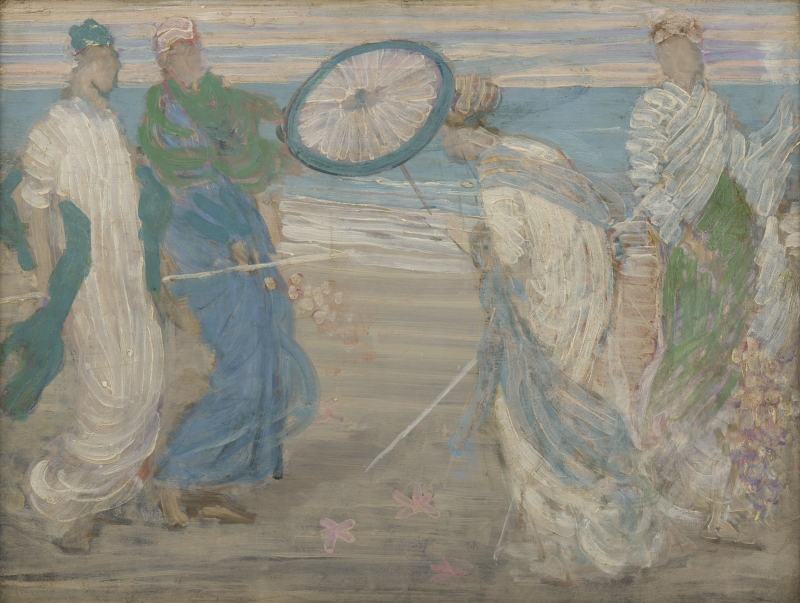Home > Catalogue > Browse > Symphony in Blue and Pink << >>
Symphony in Blue and Pink is one of the 'Six Projects' and dates from 1868. 1 The 'Six Projects' comprise Venus [YMSM 082], Symphony in Green and Violet [YMSM 083], Variations in Blue and Green [YMSM 084], Symphony in White and Red [YMSM 085] and Symphony in Blue and Pink [YMSM 086] and The White Symphony: Three Girls [YMSM 087].
This group of paintings was mentioned by William Michael Rossetti (1829-1919) in his diary for 28 July 1868, when he wrote that Whistler was 'doing on a largish scale for Leyland the subject of women and flowers.' 2
In September 1870 Whistler wrote to the artist Albert Joseph Moore (1841-1893) that Frederick Richards Leyland (1832-1892) had shown him Moore's paintings, and he felt that one of his paintings was similar to Moore's 'yellow one'; he suggested that Moore should ask William Eden Nesfield (1835-1888) for an opinion:
'your two beautiful sketches were shown to me by Leyland, - and while admiring them as you know I must do every thing of yours - more than the production of any living man - it struck me dimly - perhaps - and with great hesitation that one of my sketches of girls on the sea shore, was in motive not unlike your yellow one - of course I dont mean in scheme of color but in general sentiment of movement and in the place of the sea - sky and shore &c - - Now I would stop here and tare [sic] this letter up as I have done others if I were not sure that you could not impute to me self sufficiency enough to suppose that I could suggest for a moment that any incomplete little note of mine could even unconsciously have remained upon the impression of a man of such boundless imagination and endless power of arrangement as yourself … Now what I would propose is that you should go with Billy Nesfield down to my place and together look at the sketch in question (it is hanging up on the wall in the studio,) ... The one I mean is one in blue green and flesh color of four girls careering along the sea shore, one with a parasol the whole very unfinished and incomplete - But [what] I want you two to see is whether it may be dodged that we may each by any suggestion of yours that we may each paint our picture without harming each other in the opinion of those who do not under-stand us … Or more clearly if after you have painted yours I may still paint mine without suffering from any of the arrangement either of the sea and shore or the mouvement [sic] of the figures ... If however Nesfield and you find that I am unecessarily [sic] anxious and that I am altogether mistaken I will be more than satisfied.' 3
W. E. Nesfield replied:
'I strongly feel that you have seen & felt Moores specialitè in his female figures, method of clothing them & use of colored muslin also his hard study of Greek work - Then Moore has thoroughly appreciated & felt your mastery of painting in a light key ... I conscientiously think thus - In answer to your question "could each paint the two pictures without harming each in the opinion of those who do not understand you both" I am quite certain you both may - The effect & treatment are so very wide apart, that there can be no danger from the vulgar fact of there being, shore, sea, & sky, & a young woman walking on the foreground.' 4
Whistler probably met Moore in 1865. At about the time that Whistler was engaged on Symphony in Blue and Pink [YMSM 086], F. R. Leyland commissioned a pair of pictures from Albert Moore. These were Sea Gulls (Williamson Art Gallery and Museum, Birkenhead) and Shells (Walker Art Gallery, Liverpool), a single figure with windblown draperies, walking by the sea, which may be the work referred to in Whistler's letter to Moore.
Elizabeth Prettejohn comments that while Whistler was concerned at similarities between his painting and Albert Moore's Sea Gulls, it is in some ways closer to Greek Girls Picking up Pebbles by the Sea (ca 1871, private collection) by Frederick Leighton (1830-1896). 5 The paintings by Moore and Leighton were both shown at the Royal Academy in 1871, but both, as Prettejohn notes, are considerably less animated than the figures and seascape in Whistler's painting.
Last updated: 4th December 2020 by Margaret






